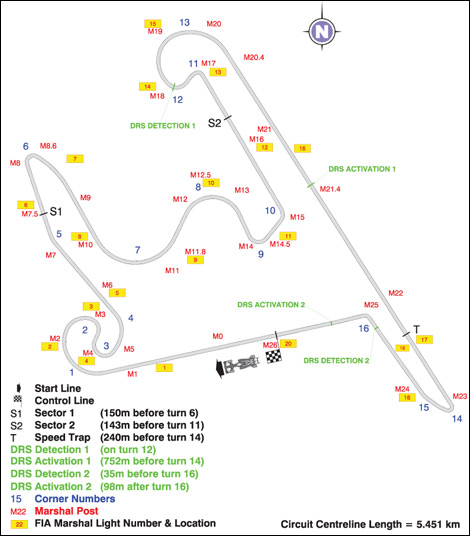Apr
10th
Stay connected Subscribe to our RSS feed
The circuit of Shanghai, home of the Grand Prix of China, will feature two DRS (Drag Reduction System) zones.
For the Formula 1 engineers, this circuit is divided into three main sectors.
Length (km): 5.451
Average speed (km/h): 193
Top speed (km/h): 321
% of lap at full throttle: 49
Fuel consumption (litres per lap): 2.45
Fuel consumption (litres per 100km): 64
SECTOR 1
Turns 1 - 4
The slowest complex on the track is the radial turn from T1 through to T4 where the track tightens on itself and the driver progressively loses speed. Engine braking support and driveability needs to be consistent here to give a stable rear end and avoid excessive wheelspin, which costs both lap time and increases tire wear. To reduce locking and improve the wear rate, engineers will map the engine to reduce engine braking when the driver lifts his foot off the pedal. This squares up the rear of the car, stops it from locking and reduces the tire wear as a result. This phenomenon of reducing engine braking when the driver is off the throttle is called ‘overrun'.
SECTOR 2
Turns 12 and 13
Turns 12 and 13, which form the radial corner that leads onto the long straight, are the mirror image of the first complex. Again, creating car stability will decrease lap time, particularly when the tires are worn or wearing down. Another means of creating stability is to change the pedal maps, ie. the percentage of torque delivered in relation to the percentage of pedal application. While the throttle application needs to correspond roughly to the torque delivered, small variations can make a real difference in the stability of the car. In this complex a soft pedal map - where the engine delivers relatively less torque at a low pedal position - is likely to be used so the driver initially has more modulation to avoid wheelspin, which wears the tires unnecessarily.
SECTOR 3
Straight between T13 and T14
The straight between turns 13 and 14 is a touch over 1,300km and the RS27 will sit at full throttle for between 17 and 18 seconds - longer than it takes for a small airplane to take off! Given this period of time, which equates to about 20% of the lap time, it is essential to calibrate the engine and gear ratios to maximise acceleration without compromising maximum speed. Short ratios favour acceleration, which means getting up to speed in a shorter distance over the first part of the straight, while a longer top gear ratio permits higher maximum speed, which is important on the second part of the straight.
For the Formula 1 engineers, this circuit is divided into three main sectors.
Length (km): 5.451
Average speed (km/h): 193
Top speed (km/h): 321
% of lap at full throttle: 49
Fuel consumption (litres per lap): 2.45
Fuel consumption (litres per 100km): 64
SECTOR 1
Turns 1 - 4
The slowest complex on the track is the radial turn from T1 through to T4 where the track tightens on itself and the driver progressively loses speed. Engine braking support and driveability needs to be consistent here to give a stable rear end and avoid excessive wheelspin, which costs both lap time and increases tire wear. To reduce locking and improve the wear rate, engineers will map the engine to reduce engine braking when the driver lifts his foot off the pedal. This squares up the rear of the car, stops it from locking and reduces the tire wear as a result. This phenomenon of reducing engine braking when the driver is off the throttle is called ‘overrun'.
 |
| Image: FOM |
SECTOR 2
Turns 12 and 13
Turns 12 and 13, which form the radial corner that leads onto the long straight, are the mirror image of the first complex. Again, creating car stability will decrease lap time, particularly when the tires are worn or wearing down. Another means of creating stability is to change the pedal maps, ie. the percentage of torque delivered in relation to the percentage of pedal application. While the throttle application needs to correspond roughly to the torque delivered, small variations can make a real difference in the stability of the car. In this complex a soft pedal map - where the engine delivers relatively less torque at a low pedal position - is likely to be used so the driver initially has more modulation to avoid wheelspin, which wears the tires unnecessarily.
SECTOR 3
Straight between T13 and T14
The straight between turns 13 and 14 is a touch over 1,300km and the RS27 will sit at full throttle for between 17 and 18 seconds - longer than it takes for a small airplane to take off! Given this period of time, which equates to about 20% of the lap time, it is essential to calibrate the engine and gear ratios to maximise acceleration without compromising maximum speed. Short ratios favour acceleration, which means getting up to speed in a shorter distance over the first part of the straight, while a longer top gear ratio permits higher maximum speed, which is important on the second part of the straight.
 The latest auto news, reviews, prices, product and vehicle releases.
The latest auto news, reviews, prices, product and vehicle releases.